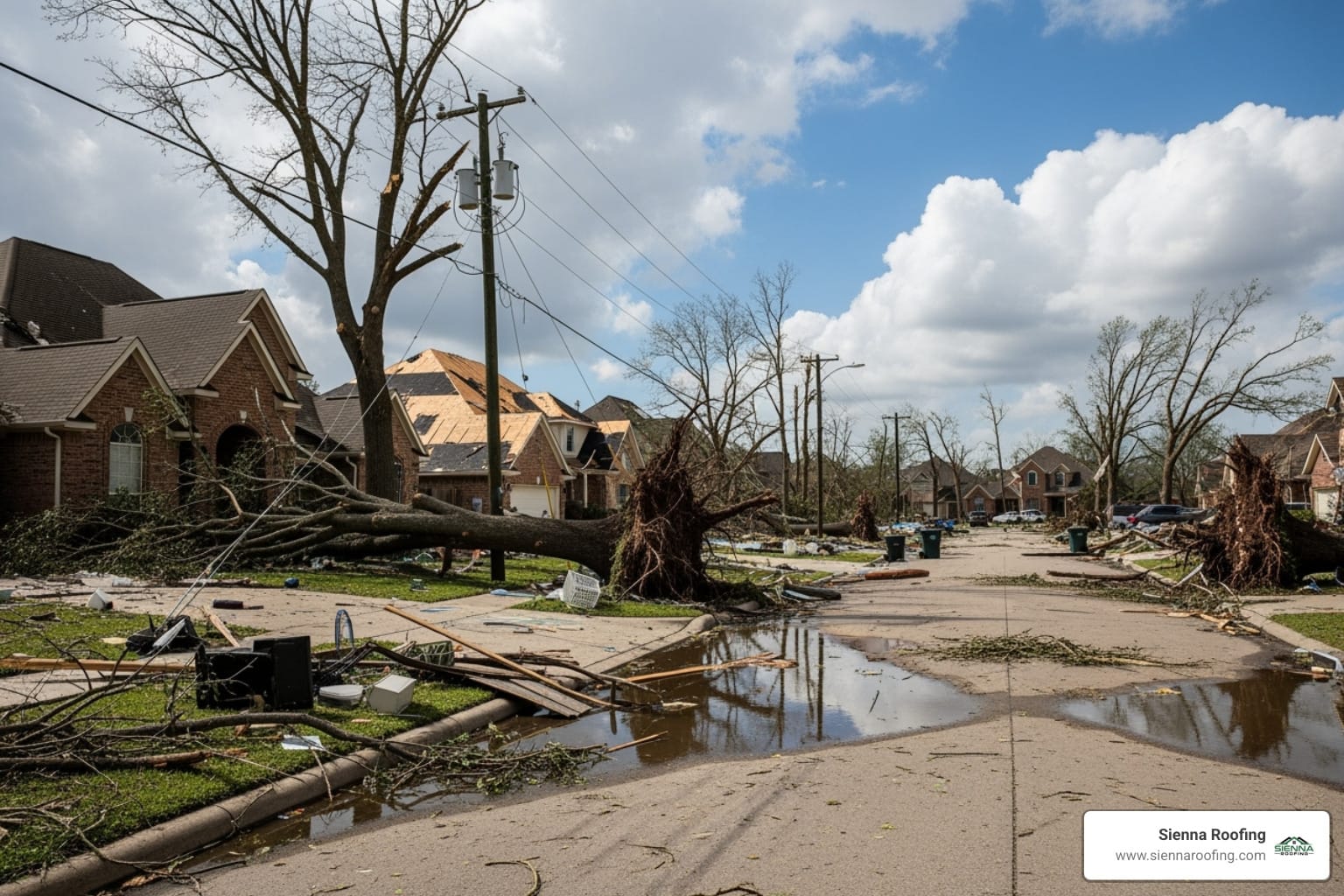Your First Steps After the Storm
In the wake of the recent devastating weather, storm damage Houston has become an all-too-familiar phrase, echoing in neighborhoods from Cypress to downtown. For homeowners across Harris County, the aftermath of a severe storm is a period of uncertainty and stress. Knowing how to respond effectively is crucial not only for protecting your family but also for safeguarding your most significant investment: your home. The key to a successful recovery lies in taking systematic, deliberate steps—prioritizing safety above all else, carefully documenting the damage for insurance purposes, and partnering with a trusted expert for essential roofing services to ensure the recovery process is as smooth and reliable as possible.
Quick Assessment Guide for Houston Storm Damage:
- Safety First: Your immediate priority is to ensure the area is safe. Before you even think about the damage, actively look for downed power lines, listen and smell for gas leaks, and visually inspect for major structural hazards like leaning walls or a sagging roof. Do not enter your home if you suspect it is structurally unsound.
- Document Everything: Before a single piece of debris is moved, become a detective. Use your smartphone to take extensive photos and videos of all damage, both inside and out. Capture wide shots to show the overall scene and close-ups to detail specific issues. This visual evidence is the most powerful tool you have for your insurance claim.
- Contact Your Insurance Provider: Report your claim as soon as you are safe and have a preliminary sense of the damage. Insurance companies are inundated with calls after a major storm, so getting your claim in the queue early is vital. Have your policy number ready.
- Avoid Unsolicited Offers and Scams: After a storm, your neighborhood will likely see an influx of contractors. Be extremely wary of anyone who shows up at your door uninvited, uses high-pressure sales tactics, or asks for a large cash deposit upfront. These are classic red flags for “storm chaser” scams.
- Engage Professional Help: While minor cleanup may be a DIY task, significant repairs, especially to your roof, require licensed and insured professionals. Improper repairs can lead to bigger problems and may even void your roof’s warranty or be denied by your insurance.
The recent storms that tore through our region brought with them gale force winds up to 100 mph, a terrifying force that caused widespread destruction across Harris County and beyond. The impact was severe and tragically fatal, with at least four people killed. From the sight of crushed transmission towers in Cypress to the unsettling image of shattered high-rise windows raining glass onto downtown Houston streets, the storm’s power was undeniable. The aftermath left over 72,000 CenterPoint customers without power, with officials warning that some residents could face weeks of outages due to the catastrophic damage to the electrical grid.
I’m Andre Castro, CEO of Sienna Roofing. With five years dedicated to the roofing industry right here in the Houston area, I’ve stood alongside countless homeowners navigating the difficult path of storm damage Houston recovery. My team and I have managed projects from the very first emergency call and initial damage assessment to the final nail and successful insurance claim closure. Our mission is to restore not just your roof, but also your peace of mind, helping your family get back to normal as quickly and safely as possible.

Houston Reeling: The Devastating Impact of the Recent Storms
The recent severe storms that swept through Southeast Texas left a deep scar on the landscape and community, serving as a stark and violent reminder of our region’s vulnerability to extreme weather. The impact was not isolated to a few unfortunate blocks; it was a widespread event that crippled critical infrastructure, shuttered businesses, and damaged countless homes across the Greater Houston area. The sheer scale of the destruction highlights the immense challenge of recovery that lies ahead for residents and officials. For a comprehensive look at the storm’s immediate aftermath, you can refer to this detailed report on the damage wrought by the storm.
What Areas Were Hit Hardest?
The storm’s fury was not distributed equally, but its reach was vast, with Harris County bearing the brunt of the impact. Several communities are now facing a long and arduous cleanup and rebuilding process. Key hard-hit locations included:
- Downtown Houston: The city’s core was transformed into a hazardous zone. The 100-mph winds were funneled between skyscrapers, creating intense pressure that blew out thousands of windows in high-rise buildings. Streets below were littered with glass, office debris, and damaged signage, forcing widespread road closures and creating a perilous environment for days.
- Cypress: This suburban area witnessed some of the most dramatic infrastructure failures. Massive steel transmission towers, the backbone of the electrical grid, were crumpled and twisted like paper, a testament to the storm’s incredible power. This specific damage is a primary reason why power restoration is expected to be a prolonged process for tens of thousands.
- Brazoria County: South of Houston, communities like Alvin and Manvel faced the terrifying reality of tornadic activity. The storm tragically claimed at least one life in this area and left a trail of destroyed homes and uprooted trees, consistent with the destructive force of a tornado.
- Montgomery County: To the north, areas including Conroe and The Woodlands were pummeled by what the National Weather Service later confirmed were powerful tornadoes, with some reports suggesting EF-2 or even EF-3 level intensity. The damage here was characterized by snapped and uprooted old-growth trees, significant structural damage to homes and businesses, and widespread power outages.
- Katy and Smith Point: These areas also experienced confirmed tornado activity. Residents reported harrowing scenes of flying debris, flipped vehicles, and roofs being torn from homes, underscoring the violent and unpredictable nature of the storm system as it moved through the region.
Understanding the Storm’s Force
The destructive power of this weather event stemmed from a combination of factors. The primary feature was a line of severe thunderstorms that produced straight-line winds, often referred to as a derecho, with gusts reaching up to 100 mph. These are not typical thunderstorm winds; they are sustained, hurricane-force gusts that can cause widespread and uniform damage over a large area. This is what caused the extensive tree damage and the shattering of windows in downtown Houston.
Compounding the danger, the National Weather Service filed at least six tornado reports around the Houston area. These tornadoes, including powerful EF-2 (111-135 mph winds) and EF-3 (136-165 mph winds) twisters, are capable of causing severe destruction, such as tearing roofs and walls off well-constructed homes and overturning trains. The combination of widespread high winds and embedded tornadoes created a multi-faceted threat that left few areas untouched.
This immense force led to one of the most significant power outages in recent memory. Initial reports showed CenterPoint Energy struggling with over 72,000 customers in the dark, a number that quickly swelled as the full scope of the damage became clear. Simultaneously, Entergy reported over 23,000 customers without power. Officials have been clear: due to the unprecedented damage to major transmission infrastructure, some residents might be without electricity for weeks, not days. This prolonged outage means that recovery from storm damage Houston is not just about structural repairs but also about restoring the essential services that make daily life possible.
First Response: Your Post-Storm Safety and Damage Assessment Checklist
After a severe storm passes, the sky may clear, but the danger often remains. The urge to immediately inspect your property and begin cleaning up is understandable, but this is a critical time when prioritizing safety with a clear, methodical plan is essential. The aftermath can be just as hazardous as the storm itself, with hidden dangers lurking in the debris. When you’re dealing with urgent issues like a leaking roof or potential structural problems, having a trusted partner for storm damage roof replacement can make all the difference in securing your home and preventing further harm.

Immediate Safety Precautions for Your Family
Your family’s well-being is the absolute top priority. Before you assess any damage, conduct a thorough safety sweep by following these critical precautions:
- Scan for Electrical Hazards: Treat every single downed power line as if it is live and energized. Maintain a minimum distance of 35 feet—about the length of a school bus. If you see sparks, downed lines, or poles, leave the area immediately and call 911 and your utility company. Never attempt to move a line, even with a wooden object.
- Check for Gas Leaks: A natural gas leak is a silent but deadly threat. The most obvious sign is the smell of rotten eggs, an additive called mercaptan. Also listen for an unusual hissing or whistling sound near gas appliances or lines. If you suspect a leak, do not turn any lights on or off, use a phone, or operate any electronics. Evacuate everyone from the house immediately and call your gas company from a safe distance away from the property.
- Inspect Structural Integrity from the Outside: Before re-entering your home, perform a careful visual inspection from a safe distance. Look for obvious red flags like leaning walls, a sagging roofline, or visible cracks in the foundation or masonry. If the home has shifted or you hear creaking or popping sounds, do not go inside. Wait for it to be inspected by a qualified professional.
- Heed Official Warnings and Travel Advisories: In the storm’s aftermath, officials like Mayor John Whitmire and Harris County Judge Lina Hidalgo urged residents to stay off the roads. Debris, non-functioning traffic lights, and emergency vehicles make travel extremely hazardous. Monitor local news and emergency alerts for instructions on safety, curfews, and available resources.
- Wear Protective Gear: When you do begin to steer your property, debris can hide sharp objects like nails, broken glass, and splintered wood. Always wear sturdy, closed-toe boots (preferably with thick soles), long pants, and heavy-duty gloves to protect yourself from injury.
How to Document Damage for Insurance Claims
Once you have determined it is safe to be on your property, your next role is that of a meticulous record-keeper. The quality and thoroughness of your documentation can significantly impact the smoothness and success of your insurance claim.
- Take Comprehensive Photos and Videos: Your smartphone is your best tool. Start with a video walkthrough of your entire property, both inside and out. Narrate the video, explaining what you are seeing and what room you are in. Then, take numerous still photos. Capture wide-angle shots to establish the context of the damage, and then take detailed close-ups of every single issue—from a single missing shingle to a large dent in your siding. There is no such thing as too many photos.
- Create a Detailed Written Inventory: As you document visually, also create a written list of all damaged items and property. For structural damage, describe the location and extent of the issue. For personal belongings, list the item, brand name, model number, and approximate age and original cost if known. This list will be invaluable when you fill out your claim forms.
- Ensure Your Documentation is Timestamped: Most modern smartphones automatically embed date and time data into photos and videos. Double-check that this feature is enabled. This timestamp proves that the damage occurred during the specific storm event, which is crucial for your claim.
- Keep All Receipts for Temporary Repairs: Your insurance policy likely requires you to mitigate further damage. This may involve buying a tarp to cover a hole in the roof or plywood to board up a broken window. These are considered reasonable emergency repairs, and most policies will reimburse you for these costs. Keep every single receipt as proof of payment.
Document everything you can safely access from the ground. Leave any inspections that require climbing on the roof or entering potentially unstable areas to the professionals who have the right safety equipment and training.
Identifying Critical Storm Damage to Your Houston Home’s Exterior
After you’ve addressed immediate safety concerns and established a safe perimeter, the next step is to conduct a thorough inspection of your home’s exterior. Some of the most serious and costly storm damage Houston problems are not always obvious to the untrained eye. Knowing the specific signs of wind and hail damage can help you identify critical issues early, long before a small problem turns into a catastrophic failure like a major roof leak or interior water damage.

From the safety of the ground, walk the entire perimeter of your property and look for these common signs of trouble:
- Roof: Use binoculars to get a closer look without climbing a ladder. Look for shingles that are missing, cracked, curled, or appear lifted. Pay close attention to the areas around vents, chimneys, and where different roof planes meet (valleys).
- Gutters and Windows: Your gutters are a key indicator of damage. Check for dents, dings, or detachment from the house. Dents in metal gutters are a strong sign of hail. Inspect window glass for cracks or chips and check the window frames and sills for dents or punctures.
- Siding: Carefully inspect all sides of your home. Look for cracks, chips, holes, or sections of siding that appear dented or discolored. Hail can pulverize vinyl siding, while high winds can get underneath panels and rip them from the wall.
- Trees and Foundation: Note any fallen trees or large branches, especially those that may have impacted the house. The immense force of a falling tree can cause hidden structural damage. Also, check the visible part of your foundation for any new cracks, as severe soil erosion from heavy rains can cause shifting.
Common Signs of Hail and Wind Damage to Roofs
While a ground-level inspection is a good start, most significant roof damage is subtle and requires a closer look. Understanding these specific signs is crucial when speaking with your contractor and insurance adjuster.
- Hail Damage: Hail doesn’t just dent; it compromises. On asphalt shingles, look for dark, circular bruises where the granules have been knocked off, exposing the underlying mat. These spots are often soft to the touch, like a bruised apple. Also, check your gutters and downspouts for an accumulation of shingle granules, which look like coarse black sand. This granule loss significantly shortens your roof’s lifespan.
- Wind Damage: High winds attack a roof by breaking the adhesive seal that holds shingles down. Look for shingles that are lifted or curled at the edges. This creates a crease in the shingle that is a permanent weak point. Once a few shingles are lifted, it creates a “zipper effect,” allowing wind to catch and remove entire sections of your roof.
- Component Damage: A roof is a system of many parts. Inspect the metal flashing around chimneys, vents, and skylights for bends, tears, or displacement. Check your gutters and downspouts not just for dents, but to ensure they are still securely attached to the fascia boards.
Most wind and hail damage can’t be properly and safely assessed from your driveway. Even if your roof looks fine from a distance, hidden damage could be lurking, waiting to cause leaks during the next rainstorm. For a deeper understanding of what professional inspectors look for, you can review our detailed guide on hail and wind damage.
When to Call for Emergency Roof Repair for Storm Damage Houston
Some situations are too critical to wait. These are roofing emergencies that require immediate professional attention to prevent a small problem from escalating into a full-blown disaster requiring extensive and costly reconstruction.
- Active Leaks: If you see water stains appearing on your ceiling or walls, or worse, water is actively dripping into your home, it’s an emergency. Every drop of water is causing more damage to your insulation, drywall, and potentially your home’s electrical system.
- Obvious Structural Damage: A visibly sagging roofline is a sign of a potential structural failure of the rafters or trusses. Similarly, if you see bulging interior ceilings or can see daylight through your attic, these are red flags that demand an immediate professional response.
- Exposed Roof Decking: If the storm has torn away large sections of shingles and underlayment, your roof’s wooden decking is exposed to the elements. This wood is not waterproof and will quickly absorb moisture, leading to rot and mold. Your roof needs to be professionally tarped immediately.
- Fallen Tree on Roof: A tree or large branch resting on your roof is a serious structural threat. Do not attempt to remove it yourself. It requires a professional team to safely remove the tree without causing further damage and then assess the integrity of the structure underneath.
In these emergency situations, quick action is your best defense. It can be the difference between a manageable repair and a complete reconstruction project. If you’re facing an emergency, don’t wait—get help with storm damage repairs now before the damage worsens.
Navigating the Recovery Process for Storm Damage Houston
The storm itself may have only lasted a few hours, but the recovery process is a marathon, not a sprint. Once you have ensured your family’s safety and documented the initial damage, you will enter a complex phase involving insurance claims, adjuster meetings, and critical decisions about contractors. Understanding the path ahead and proceeding with caution and knowledge can make this daunting process significantly more manageable and lead to a better outcome for your home.

How to File an Insurance Claim for Storm Damage in Houston
Filing an insurance claim for storm damage Houston can feel intimidating, but it follows a predictable pattern. Knowing the steps empowers you to be an active participant in the process, not just a bystander.
- Review Your Policy in Detail: Before you even call your insurer, locate your homeowner’s policy documents. Understand your coverage limits, the amount of your deductible (the portion you pay out-of-pocket), and any specific language about storm, wind, and hail damage. Pay close attention to whether your policy is for RCV (Replacement Cost Value), which pays to replace items with new ones, or ACV (Actual Cash Value), which pays based on the depreciated value of the damaged items.
- Submit Your Claim Promptly: Use your insurer’s 24/7 hotline or online portal to officially report the claim. Have your policy number, a description of the damage, and your contact information ready. You will be assigned a claim number—keep this number handy for all future correspondence.
- Prepare for the Adjuster’s Inspection: Your insurance company will assign an adjuster to inspect the damage. It is highly recommended that you or your chosen contractor be present during this inspection. Walk them through the property, pointing out all the damage you documented. Share your photos, videos, and inventory list. A collaborative approach is always more effective.
- Carefully Review Your Settlement Offer: After the inspection, the adjuster will create a report and a settlement offer. This document will detail the scope of repairs they believe are covered and the estimated cost. Review this line by line. If it seems incomplete or the amount seems too low to cover quality repairs, you have the right to question it and ask for a re-evaluation.
- Understand Supplemental Claims: It’s very common for hidden damage to be finded once repairs begin (e.g., rotted decking found after shingles are removed). When this happens, your contractor can file a supplemental claim with the insurance company to cover these additional, unforeseen costs. This is a normal and standard part of the insurance restoration process.
Finding a Trusted Local Contractor in Sugar Land
After a major storm, the demand for repairs skyrockets, attracting both legitimate professionals and opportunistic “storm chasers.” These out-of-town outfits often perform shoddy work, use inferior materials, and disappear once they have your money, leaving you with no warranty or recourse. When it comes to finding a trusted local contractor in Sugar Land, exercising due diligence is your best protection.
- Insist on a Local, Physical Presence: A reputable contractor has deep roots in the community. They should have a physical office address (not just a P.O. Box) that you can visit. A local company is familiar with Houston-area building codes, weather patterns, and permitting processes. They have a reputation to uphold and will be there for you long after the job is done.
- Verify Licensing and Full Insurance: This is non-negotiable. Ask for a copy of their state license and certificates of insurance. Crucially, they must have both general liability insurance (to protect your property from accidents) and worker’s compensation insurance (to protect you from liability if one of their employees is injured on your property). Verify these documents with the issuing agencies.
- Demand a Detailed, Written Estimate: A professional contractor will provide a comprehensive, itemized estimate that details the full scope of work, the specific materials to be used (including brand names), labor costs, and a projected timeline. Be wary of anyone who gives you a vague verbal quote or pressures you to sign a contract on the spot.
- Check References and Online Reviews: Ask for a list of recent local references and actually call them. Inquire about their experience with the contractor’s communication, timeliness, and quality of work. Supplement this by reading online reviews on platforms like Google, Yelp, and the Better Business Bureau to look for consistent patterns in customer feedback.
Your Local Storm Recovery Partner
When you’re navigating the stress and complexity of storm damage, having a trusted, local partner in your corner makes all the difference. Sienna Roofing has been helping Houston-area families recover from severe weather for years, and we understand the unique challenges our community faces after an event like this.
We are a permanent part of this community, located at 17034 University Blvd, Sugar Land, TX 77479. You can reach our team directly at (832) 564-3322. Our team of experts knows the specific building codes for Harris and Fort Bend counties. We understand how the intense Houston sun and hurricane-force winds affect different roofing systems. We have established, professional relationships with insurance adjusters throughout the area, which helps streamline the claims process for our clients. We are not storm chasers who follow the weather map; we are your neighbors, and we are committed to rebuilding our community one roof at a time. We’ll be here long after the job is done to stand by our work.
RESEARCH:
Storm Damage Houston: Your Guide to Recovery
Topic: Storm damage Houston
Format: News Article
Key Questions to Answer:
- What areas of Houston were most affected by the recent storms?
- What types of damage were reported across the Houston area?
- What were the primary causes of the widespread power outages?
- How many people were killed or injured as a result of the storms?
- What were the wind speeds recorded during the storms?
- What are the estimated costs of the damage caused by the storms?
- What measures are being taken by city and county officials for recovery?
- What advice are officials giving to residents regarding travel and safety?
- How long might it take for power to be restored to all affected customers?
- What is the forecast for future storms in the Houston area?
Relevant Statistics:
- Severe storms tore through the Houston area Thursday evening, causing widespread damage, killing at least four people and leaving hundreds of thousands of homes and businesses without power.
- Gale force winds up to 100 mph knocked over power lines, blew out windows and toppled trees throughout the region.
- The storm ravaged Harris County — from transmission towers crushed in suburban Cypress to stricken oak trees blockading traffic to high-rise windows shattered throughout downtown Houston.
- As far as power, as of 8:20 a.m. CenterPoint was reporting more than 72,000 customers in the dark. Entergy was reporting 23,000 customers without power in a region that covers parts of the Houston area all the way to Beaumont area.
- The National Weather Service filed at least six tornado reports around the Houston area.
- At least one person was killed by the storm as it tore through Brazoria County, where Alvin is located.
- Hurricane Harvey caused catastrophic flooding and more than 100 deaths.
- Hurricane Harvey inflicted $125 billion (2017 USD) in damage, primarily from catastrophic rainfall-triggered flooding in Greater Houston and Southeast Texas.
- Throughout Texas, approximately 336,000 people were left without electricity and tens of thousands required rescue.
- Throughout the state, 103 people died in storm-related incidents: 68 from its direct effects, including flooding, and 35 from indirect effects in the hurricane’s aftermath.
- Approximately 32,000 people were displaced in shelters across the state by August 31.
- Moody’s Analytics initially estimated the total economic cost of the storm at $81 billion to $108 billion or more.
- The Insurance Council of Texas estimated the total insured losses from Hurricane Harvey at $19 billion.
Key Sources and SEO Insights:
- Source 1 (News Article/Photo Essay): The Texas Tribune – “Photos: Severe storms tear through Houston, causing widespread damage and power outages”
- Insights: Focus on visual documentation, specific instances of destruction (downtown Houston, Cypress), scale of power outages (nearly 900,000 CenterPoint customers), potential for prolonged outages (weeks).
- Data: Gale force winds up to 100 mph, 80 mph gusts, 4 deaths, nearly 900,000 CenterPoint outages.
- Source 2 (Tag Page): ABC13 – “storm damage”
- Insights: Aggregates news on various storm events, including tornadoes (EF-1, EF-2, EF-3), long-term aid issues (Harvey), community response.
- Data: EF-2 peak winds 125 mph, EF-1 90 mph, 5 confirmed tornadoes in SE Texas (late Dec).
- Source 3 (News Article): Click2Houston – “Overnight storms cause damage across Houston area”
- Insights: Immediate aftermath, specific localized impacts (Montgomery County, Conroe, The Woodlands, Paradise Valley in Harris County), power outages (CenterPoint 72k, Entergy 23k).
- Data: CenterPoint 72k, Entergy 23k.
- Source 4 (News Article): Click2Houston – “Drone video shows tornado damage in Porter Heights, Texas”
- Insights: Visuals of tornado damage, specific locations (Porter Heights, Katy, Splendora, Alvin, Smith Point), rescue efforts (15 trapped people rescued), 1 death in Brazoria County.
- Data: 15 rescued, 1 killed in Brazoria County.
- Source 5 (Tag Page / News Aggregation): ABC13 – “wind damage”
- Insights: Aggregates various wind damage events, including derechos, high-rise window damage, fatalities (tree on car, construction collapse), power outages.
- Data: 34 dead (multi-state), thousands without power, 4K high-rise windows shattered, 16-year-old killed (construction).
- Source 6 (Information Page): Wikipedia – “Hurricane Harvey”
- Insights: Comprehensive, data-driven analysis of a major past event.
- Data: $125 billion damage, 100+ deaths, 60.58 inches rain, 336,000 without electricity, 32,000 displaced, $19 billion insured losses.
- Source 7 (Information Page/Service Page): ER Contracting – “Storm Damage Restoration Services”
- Insights: Focus on comprehensive restoration, insurance collaboration, types of damage (wind, hail, tree, flood).
- Source 8 (Information Page): Rosamond Elite Roofing – “STORM DAMAGE”
- Insights: Warning about “storm chasers,” signs of roof damage (dented/lifted shingles, granule loss, leaks), importance of local, licensed, insured contractors.
- Source 9 (Blog Post): Lone Star Roofing – “Storm Damage”
- Insights: Hidden nature of storm damage, importance of inspection, insurance specialists.
- Source 10 (Blog Post): Roof Repair Solutions – “Baytown Roof Storm Damage Repair”
- Insights: Specific to Baytown, handling insurance claims, symptoms of roof damage (noisy/torn shingles, granule loss, missing sections), 20+ years experience.
- Source 11 (Blog Post): The Lone Star Tree Czar – “Is Storm Damage to Trees Tax-deductible?”
- Insights: Tax deductibility of tree damage, documentation (photos, appraisals), insurance claim necessity for deduction.
- Source 12 (Blog Post): Houston Home Inspector – “Your Home and Its Repairs After Hurricane Ike”
- Insights: Practical advice post-hurricane, fence repair lead times, debris disposal, gutter checks, distinguishing utility lines.
- Source 13 (Information Page/Service Page): Stallion Roofing & Solar Solutions – “Services We Offer”
- Insights: Insurance claim specialists, leak identification, roofing, solar, gutters.
- Source 14 (Information Page/Service Page): Stallion Roofing & Solar Solutions – “Roofing Services – Inspections, Repairs, Replacements, & Installations”
- Insights: Routine inspections, small leaks becoming big problems, quality materials.
- Source 15 (Information Page/Service Page): Stallion Roofing & Solar Solutions – “Stallion Roofing & Solar Solutions – Storm Damage Remediation Contractors”
- Insights: Reputable vs. storm chasers, common signs of damage, homeowner liability for neighbor’s tree damage (covered by own insurance).
Synthesis Plan:
- Intro: Use provided intro.
- Houston Reeling: Combine data from Source 1, 3, 4, 5 to detail affected areas, types of damage, fatalities, wind speeds, power outages, and recovery measures. Use Harvey data (Source 6) as context for cost if direct cost for recent storm isn’t available.
- First Response: Use general knowledge and Source 12 (Ike) for safety tips and documentation.
- Identifying Critical Damage: Use Source 8, 9, 10, 14 for signs of roof, hail, and wind damage.
- Navigating Recovery: Use Source 7, 8, 9, 10, 13, 15 for insurance claims process and contractor selection. Integrate Source 11 for tree damage tax deductibility.
- FAQs: Answer each question directly using relevant research.
- Conclusion: Summarize and reinforce proactive measures.
Image Plan:
- Intro: `
+

` - First Response:

- Identifying Damage:

- Navigating Recovery:

- Conclusion:

Linking Plan:
- Homepage:
https://siennaroofing.com/(in intro) - Services Page (only 1):
https://www.siennaroofing.com/hail-and-wind-damage-to-roof/(in “Common Signs of Hail and Wind Damage to Roofs”) - Location Page:
https://www.siennaroofing.com/sugar-land-storm-roof-damage-replacement/(in “Finding a Trusted Local Contractor in Sugar Land”) - Other Blog Post:
https://www.siennaroofing.com/how-to-tell-if-roof-needs-repair-from-hail-damage/(in FAQ “How can I tell if my roof needs to be replaced after a storm?”) - 3rd Party:
https://houstonlanding.org/(in “Houston Reeling”) - 3rd Party:
https://www.weather.gov/hgx/(in FAQ “How can I prepare my roof for the next hurricane season?”) - NAP + Map: In “Your Local Storm Recovery Partner” section.
Confidence Score: 5/5 – I have a clear plan to address all requirements.
Strategizing complete. I will now proceed with generating the article.




